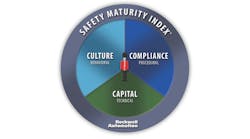The 2013 America's Safest Companies Conference began with some grisly statistics from the technology track.
"Every 15 seconds a worker dies from work-related accidents or diseases," announced Mark Eitzman, global market development manager, Safety Automation, at Rockwell Automation.
"When you toll that out," he said, "that means about 6,300 people will die today – and every day – from injuries they receive on the job."
After decades of safety programs and EHS initiatives, with all of the tools we have on hand to keep workers safe and the progress the world has made to ensure their use, he said, that figure is unacceptable.
What's more, he added, the distribution of those 6,300 daily and 2.3 million annual fatalities is frustratingly unbalanced and inconsistent despite a consistent set of laws and standards.
"There is a significant discrepancy in the contribution of these statistics from region to region, country to country, industry to industry, even company to company," Eitzman explained. "At some companies it is inconceivable that anyone would ever be maimed or killed. But at others, it is an accepted reality.
"And we wanted to know why," he said.
So Eitzman and his team at Rockwell decided to find out.
And after years of research and studies, their efforts have finally culminated in a breakthrough whitepaper released just this week called, "Safety Maturity: Three Crucial Elements of Best-in-Class Safety."
In it, author Steve Ludwig, safety programs manager at Rockwell Automation, finally nailed down the relationship between high performance and high safety standards.
"Today, best-in-class manufacturers realize that the combination of employee behavior, processes and practices, and technology implementation enable them to go far beyond simple compliance to deliver improved productivity and greater efficiencies and dramatically lower injury rates," he writes.
As Eitzman noted in his presentation, best-in-class companies – those with a 90% or higher OEE and under 2% unscheduled asset downtime – consistently show the best safety records – under 0.2% repeat accident rates and .05 injury frequency rates.
On down from there, medium-performing companies show medium level safety records and lagging companies are "lousy in both," as Eitzman put it.
In other words, safety and productivity go hand in hand far more that we previously understood.
"The benefits of optimizing safety extend far beyond fewer injuries or fines," Ludwig writes.
"Companies that approach safety holistically can improve productivity, gain efficiencies and experience improved employee morale."
The Safety Maturity Index
Proving this truism was only the first step in the process.
As Eitzman explained, the goal was to both uncover the root of the safety inconsistencies and, from those data, create a consistent measure to determine and benchmark a company's progress on its safety journey.
To do that, Eitzman unveiled Rockwell's new signature tool designed to help boost the industry: The Safety Maturity Index.
As Ludwig described it in his report, the index is a self-guided assessment tool that provides a "comprehensive measurement of performance in safety" that "helps companies understand their current level of performance and steps they can take to improve safety and profitability."
It breaks down safety investment into three areas – culture (worker and company behavior), compliance (procedures and protocols) and capital (safety technologies) – and rates them on a one-to-four scale.
It results in a tool that Eitzman said finally provides a transparent view into the maturity of companies' safety programs and how they stack up next to best-in-class manufacturers.
"On their own, most manufacturers think they are doing a good job on safety," he explained. "But for the vast majority of companies, the safety journey is something they are still on."
So far, Rockwell has found only 15% of companies have reached the SMI4 level – operational excellence – level, and only 23% SMI3 – cost avoidance. And that means 62% of companies are still fighting to meet even the minimum standards.
"We know safety is a journey," Eitzman said. "Understanding where we are today in terms of culture, compliance and capital will carry us through that journey. So this index is really the place to start."
